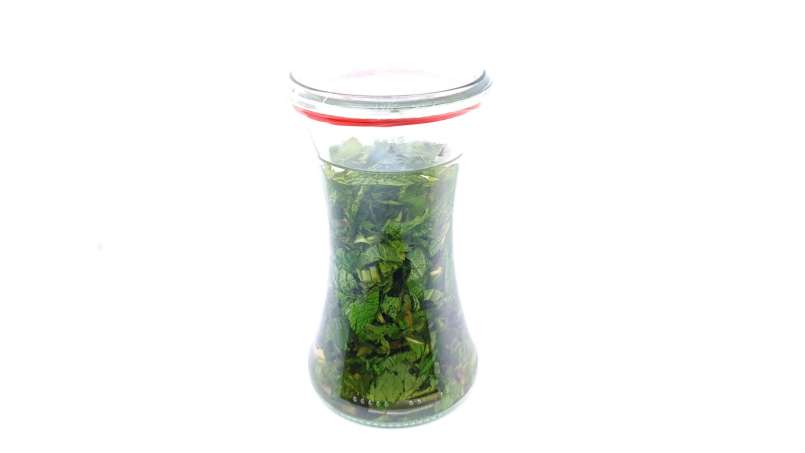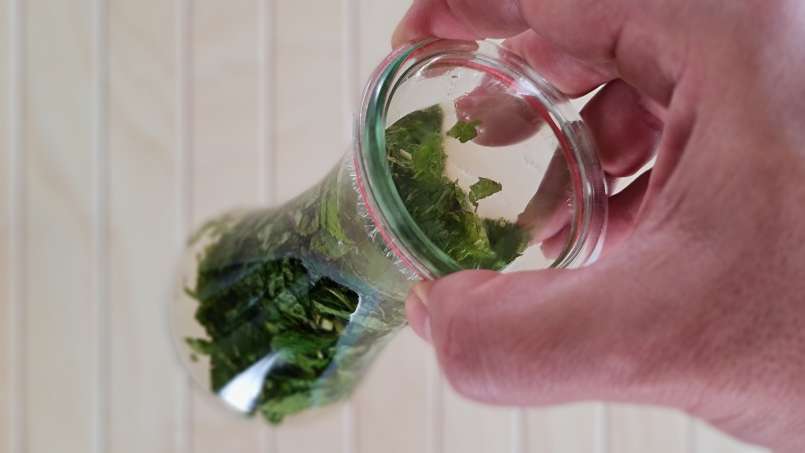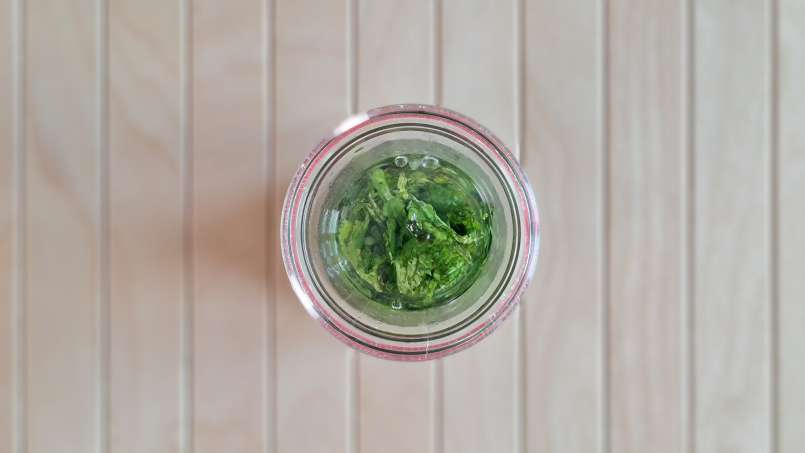Mint tincture
Preparation time10 min
Waiting time21 days
Ready in21 days 10 m
Maintains the health of the digestive tract
Mint/Peppermint tincture has an essential role in maintaining the health of the digestive system and in inducing a state of relaxation of the whole body. It can be used both internally, diluted with water, and externally, as such, diluted or part of other remedies in local applications, plastering, massage, ... We present to you how to prepare mint tincture (recipe).
Servings: 60 servings
Results ~150 ml of mint tincture = ~ 60 portions if we consider a portion ~50 drops (~2.5ml) for an adult
Ingredients
Estimated cost: 1.5 €
Materials
- - glass containers, 270 ml jar;
- - knife;
- - vegetable board;
- - strainer / gauze for filtering;
Preparation
 We will use fresh mint aerial parts (stem/twigs + leaves). This is washed under running water and we will leave it to air/dry on a kitchen towel for about an hour.
We will use fresh mint aerial parts (stem/twigs + leaves). This is washed under running water and we will leave it to air/dry on a kitchen towel for about an hour.
We will use an alcohol concentration of at least 50% alcohol by volume (grain alcohol, brandy, palinça, brandy, vodka). Crush / finely chop the mint with the help of a preferably non-metallic knife.
Crush / finely chop the mint with the help of a preferably non-metallic knife. We put the chopped mint in a clean and dry glass container (jar) without pressing it (we let it sit lightly).
We put the chopped mint in a clean and dry glass container (jar) without pressing it (we let it sit lightly). Add the alcohol until the container is full and close hermetically. It is important to have as little air as possible in the container to avoid spoilage of the plant (oxidation).
Add the alcohol until the container is full and close hermetically. It is important to have as little air as possible in the container to avoid spoilage of the plant (oxidation). We leave the mixture to macerate between 3 and 6 weeks, in a place protected from light, without humidity and slightly cool (pantry, cupboard shelf, storage room, cellar).
We leave the mixture to macerate between 3 and 6 weeks, in a place protected from light, without humidity and slightly cool (pantry, cupboard shelf, storage room, cellar).
It is good to shake the jar daily to ensure complete fusion of the herb (mint) with the alcohol. After maceration, filtering of the tincture follows, and the plant residue is thrown away. You can use a cheesecloth placed over a jar over which you pour the mixture and at the end squeeze the cheesecloth well and discard the plant pieces.
After maceration, filtering of the tincture follows, and the plant residue is thrown away. You can use a cheesecloth placed over a jar over which you pour the mixture and at the end squeeze the cheesecloth well and discard the plant pieces. The filtered liquid will be poured into small glass containers, preferably dark in color and with a dropper.
The filtered liquid will be poured into small glass containers, preferably dark in color and with a dropper.
Close the containers hermetically and label them with the name of the plant, the type of alcohol and the date of preparation.
The tincture will be stored in a cool, ventilated place, protected from light. It can also be kept in the refrigerator, but it is not necessary.
Administration
Internal:
→ It will be consumed diluted in boiled and cooled water, 30-60 drops diluted in 50 - 100 ml water, 3 times a day, after meals.
External:
→ It will be used as such, diluted with water or as part of other remedies, especially through local applications, massage, poultices, plastering.
→ Diluted with water, we will use it in a proportion of ~50-100 drops per 100 ml of water depending on the sensitivity of each one.
⚠ In children up to 7 years of age or in the case of pregnant and breastfeeding women, a doctor's recommendation is required.
→ It will be consumed diluted in boiled and cooled water, 30-60 drops diluted in 50 - 100 ml water, 3 times a day, after meals.
External:
→ It will be used as such, diluted with water or as part of other remedies, especially through local applications, massage, poultices, plastering.
→ Diluted with water, we will use it in a proportion of ~50-100 drops per 100 ml of water depending on the sensitivity of each one.
⚠ In children up to 7 years of age or in the case of pregnant and breastfeeding women, a doctor's recommendation is required.
Observations
→ Proporția ingredientelor la tinctura de mentă poate varia de la 25% plantă - 75% alcool până la 50% plantă - 50% alcool. În rețeta actuală am folosit aproximativ 40% plantă - 60% alcool.
→ Tinctura din plante proaspete este mai eficientă decât cea din plante uscate, deoarece planta proaspătă conține maximum de substanțe volatile care vor fi transferate alcoolului.
→ În cazul plantelor proaspete este recomandat ca după spălare prin clătire sub jet de apă, să se lase la uscat de la 30 minute până la 2-3 ore pentru a scoate umezeala din ele (până se ofilesc ușor).
→ Pentru a mări concentrația tincturii, se poate repeta procesul folosind drept alcool tinctura deja formată și alte plante. Astfel poți repeta procesul de macerare de 2 -3 ori, obținând o tinctură de concentrație "dublă" sau "triplă".
→ Pentru planta proaspătă este bine să folosim un alcool de concentrație cât mai mare (90%), deoarece planta are deja apă, iar in cazul plantelor uscate merge și un alcool mai slab (minim 40%).
Păstrare și valabilitate:
→ Se va păstra în sticluțe de dimensiuni mici, eventual închise la culoare și cu picurător, obligatoriu în locuri ferite de lumină, aerisite, fără umezeală și răcoroase (debara, beci, chiar și frigider).
→ Dacă se observă depuneri pe perioada păstrării, se agită flaconul înainte de utilizare.
→ Termenul de valabilitate este de 2 ani de la data preparării.
→ Tinctura din plante proaspete este mai eficientă decât cea din plante uscate, deoarece planta proaspătă conține maximum de substanțe volatile care vor fi transferate alcoolului.
→ În cazul plantelor proaspete este recomandat ca după spălare prin clătire sub jet de apă, să se lase la uscat de la 30 minute până la 2-3 ore pentru a scoate umezeala din ele (până se ofilesc ușor).
→ Pentru a mări concentrația tincturii, se poate repeta procesul folosind drept alcool tinctura deja formată și alte plante. Astfel poți repeta procesul de macerare de 2 -3 ori, obținând o tinctură de concentrație "dublă" sau "triplă".
→ Pentru planta proaspătă este bine să folosim un alcool de concentrație cât mai mare (90%), deoarece planta are deja apă, iar in cazul plantelor uscate merge și un alcool mai slab (minim 40%).
Păstrare și valabilitate:
→ Se va păstra în sticluțe de dimensiuni mici, eventual închise la culoare și cu picurător, obligatoriu în locuri ferite de lumină, aerisite, fără umezeală și răcoroase (debara, beci, chiar și frigider).
→ Dacă se observă depuneri pe perioada păstrării, se agită flaconul înainte de utilizare.
→ Termenul de valabilitate este de 2 ani de la data preparării.
Effects and benefits
- supports the normal functioning of the digestive system;
- supports the health of the gastrointestinal tract;
- fights intestinal cramps;
- has a very strong gastrointestinal antiseptic role;
- good for bacterial infections;
- fights bloating and flatulence (favors the elimination of gases accumulated in the stomach and intestines), carminative effect;
- helps in intestinal colic, enterocolitis;
- helps in slow digestion, indigestion, bloating, aerophagia;
- protects the gastro-duodenal mucosa;
- normalizes intestinal transit, regulates stool density and frequency;
- helps to calm vomiting and combats the feeling of nausea;
- sedative of hepato-biliary colic;
- helps in the secretion of bile, in diseases of the pancreas;
- adjuvant in ENT diseases;
- helps maintain the health of the respiratory tract;
- antitussive and antiviral effect;
- helps in sinusitis;
- detoxifying, favors the elimination of toxins from the body;
- mild analgesic effect;
- has a relaxing and tonic effect at the same time;
- good for headaches, migraines, when they are associated with bile problems;
- anti-inflammatory effect;
- good for soothing muscle and joint pain, in rheumatism;
- soothing and relaxing on the skin, reducing the sensation of itching and stinging (in skin rashes);
- stimulates memory, increases vigilance, degree of concentration;
- fights bad breath (eliminates bad breath);
Properties:
- digestive tonic,
- choleretic,
- cholagogue,
- antispasmodic,
- antiseptic,
- carminative,
- astringent,
- antidiarrheal,
- antiemetic,
- secretolytic,
- respiratory decongestant,
- analgesic,
- slightly anesthetic, sedative.
Side effects
- overdose can lead to diarrhea
Contraindications
- contraindicated for those with alcohol restrictions;






Comments
Nadia
It was easy to make and very nice to taste.